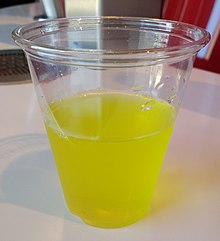 A cup of Pine-Nut Bibo at the World of Coca-Cola (2017) | |
| Type | Soft drink |
|---|---|
| Manufacturer | The Coca-Cola Company |
| Region of origin | Africa |
Bibo is a fruit juice-flavored soft drink introduced in 1998 by the Coca-Cola Company, [1] and sold in Turkey, South Africa and Mozambique. Bibo was one of a set of regional brands established around the world, including Qoo in Asia, Senzao in Mexico and Kapo in Latin America. [2]
The most popular variety is Bibo Candy Pine-Nut, a mix of pineapple and coconut. [3] Other flavors include Johnny Orange, Paolo Peach, Taka Strawberry, Tiko Lemon, Jay Apple Jr., Jo Grape, Willie Pineapple and DJ Kiwi Mango. Coca-Cola planned to bring Bibo to Eastern Europe, [4] but discontinued the drink in 2004.
In 2007, the World of Coca-Cola museum in Atlanta, Georgia opened a "tasting room" featuring 70 of the company's beverage brands, including Bibo Candy Pine-Nut, as well as the Italian soda Beverly. [5]
In 2013, the Walt Disney World Resort in Orlando, Florida introduced Bibo at the Club Cool refreshment stand at its Epcot theme park, along with other regional Coca-Cola drinks like Thailand's Fanta Melon Frosty and Zimbabwe's Sparberry. [1] Club Cool left the park, but as of 2019, the Coca-Cola Store at Disney Springs continues to offer Bibo drinks. [6]
References
- ^ a b Lee, Banks. "Club Cool at Epcot introduces new soda flavors, keeps Beverly and VegitaBeta". Attractions Magazine. Retrieved 11 July 2020.
- ^ Chaudhuri, Sumit Kumar, ed. (2006). Case Studies on Competitive Strategies, Volume 1. ICFAI Books. p. 64. ISBN 9788131401965.
- ^ Stofsky, Matt (16 May 2016). "11 International Coca-Cola Products You Can't Buy in the U.S." Mental Floss. ISSN 1543-4702. Archived from the original on 28 December 2019. Retrieved 11 July 2020.
- ^ Mueller, Barbara (2004). Dynamics of International Advertising: Theoretical and Practical Perspectives. P. Lang. p. 189. ISBN 9780820463605. Retrieved 11 July 2020.
- ^ "Atlanta goes better with Coca-Cola". Associated Press. 17 June 2007. Retrieved 11 July 2020.
- ^ Abell, Bailee (7 September 2019). "You can still get the sodas of the world after Club Cool leaves Epcot". Inside the Magic. Retrieved 11 July 2020.
 A cup of Pine-Nut Bibo at the World of Coca-Cola (2017) | |
| Type | Soft drink |
|---|---|
| Manufacturer | The Coca-Cola Company |
| Region of origin | Africa |
Bibo is a fruit juice-flavored soft drink introduced in 1998 by the Coca-Cola Company, [1] and sold in Turkey, South Africa and Mozambique. Bibo was one of a set of regional brands established around the world, including Qoo in Asia, Senzao in Mexico and Kapo in Latin America. [2]
The most popular variety is Bibo Candy Pine-Nut, a mix of pineapple and coconut. [3] Other flavors include Johnny Orange, Paolo Peach, Taka Strawberry, Tiko Lemon, Jay Apple Jr., Jo Grape, Willie Pineapple and DJ Kiwi Mango. Coca-Cola planned to bring Bibo to Eastern Europe, [4] but discontinued the drink in 2004.
In 2007, the World of Coca-Cola museum in Atlanta, Georgia opened a "tasting room" featuring 70 of the company's beverage brands, including Bibo Candy Pine-Nut, as well as the Italian soda Beverly. [5]
In 2013, the Walt Disney World Resort in Orlando, Florida introduced Bibo at the Club Cool refreshment stand at its Epcot theme park, along with other regional Coca-Cola drinks like Thailand's Fanta Melon Frosty and Zimbabwe's Sparberry. [1] Club Cool left the park, but as of 2019, the Coca-Cola Store at Disney Springs continues to offer Bibo drinks. [6]
References
- ^ a b Lee, Banks. "Club Cool at Epcot introduces new soda flavors, keeps Beverly and VegitaBeta". Attractions Magazine. Retrieved 11 July 2020.
- ^ Chaudhuri, Sumit Kumar, ed. (2006). Case Studies on Competitive Strategies, Volume 1. ICFAI Books. p. 64. ISBN 9788131401965.
- ^ Stofsky, Matt (16 May 2016). "11 International Coca-Cola Products You Can't Buy in the U.S." Mental Floss. ISSN 1543-4702. Archived from the original on 28 December 2019. Retrieved 11 July 2020.
- ^ Mueller, Barbara (2004). Dynamics of International Advertising: Theoretical and Practical Perspectives. P. Lang. p. 189. ISBN 9780820463605. Retrieved 11 July 2020.
- ^ "Atlanta goes better with Coca-Cola". Associated Press. 17 June 2007. Retrieved 11 July 2020.
- ^ Abell, Bailee (7 September 2019). "You can still get the sodas of the world after Club Cool leaves Epcot". Inside the Magic. Retrieved 11 July 2020.